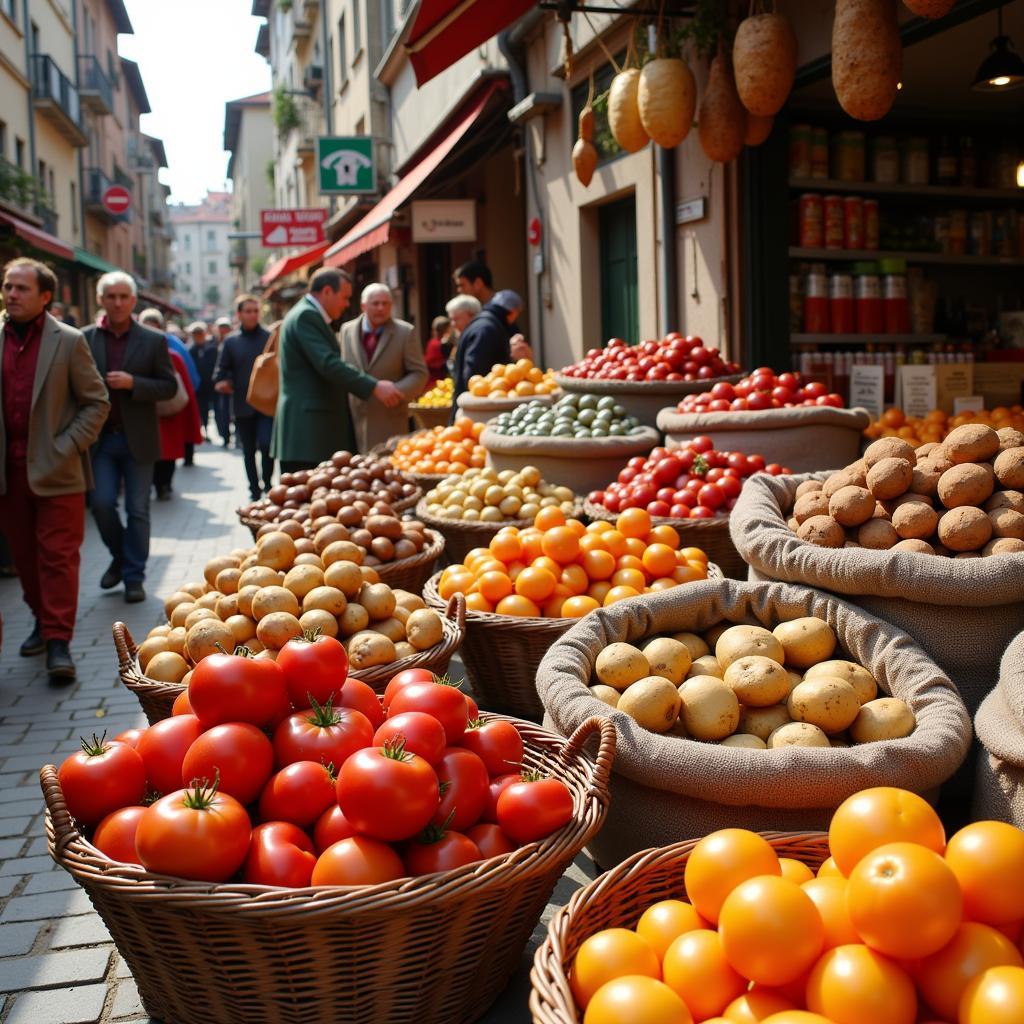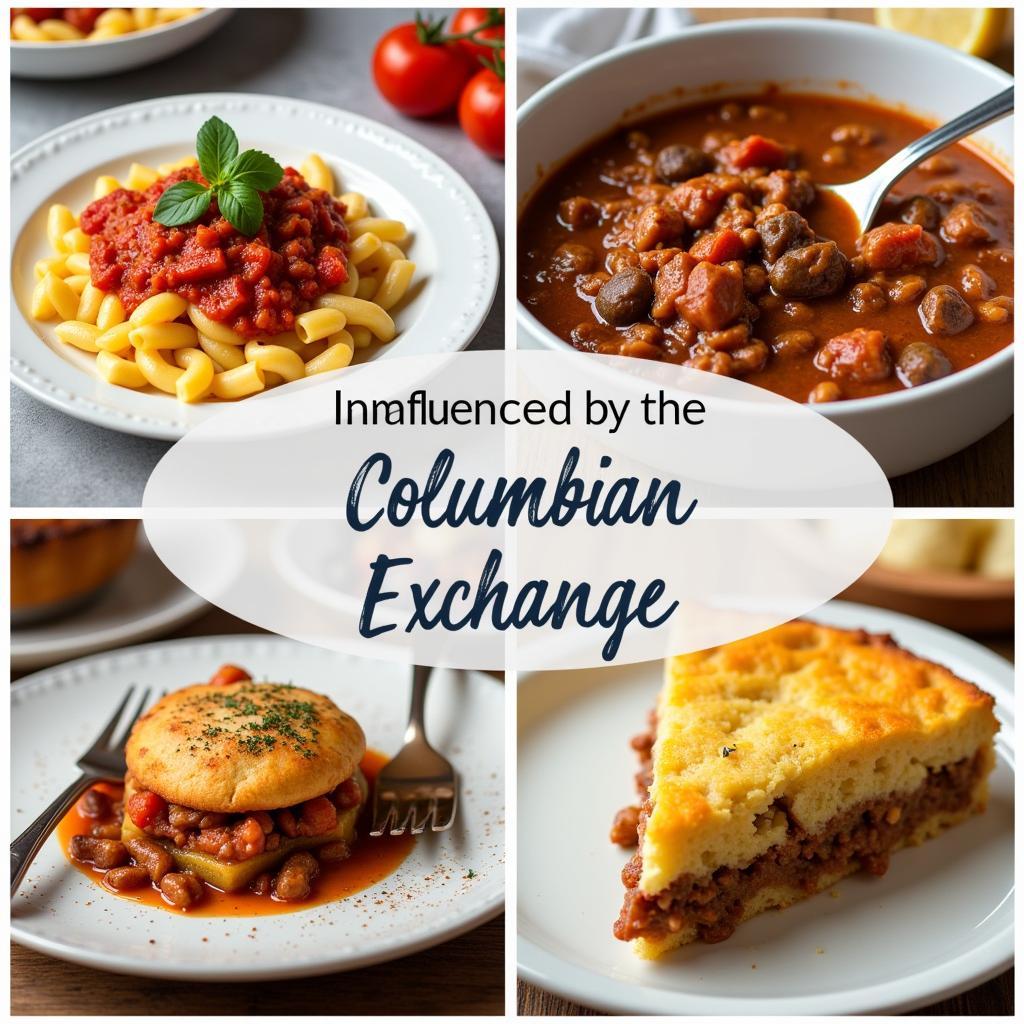The Columbian exchange dramatically reshaped the world’s culinary landscape. From the Old World to the New World and vice versa, ingredients traveled across oceans, influencing diets and inspiring countless Columbian Exchange Food Recipes. Let’s delve into this fascinating historical food fusion and discover how these ingredients transformed culinary traditions forever.
The Impact of the Columbian Exchange on Food
The Columbian Exchange, initiated in the late 15th century, wasn’t just about trade; it was a cultural revolution, especially in the realm of food. Foods we consider staples today, like tomatoes in Italian cuisine or potatoes in Irish dishes, wouldn’t exist in those cultures without this historical exchange. It introduced new flavors, textures, and cooking techniques, permanently altering food cultures globally. This exchange not only impacted what we eat but also how we prepare and appreciate food.
Old World to New World: Transforming the Americas
Imagine the Americas before the arrival of European ships. Native cuisines relied heavily on corn, beans, squash, and chili peppers. The Columbian exchange introduced livestock such as cattle, pigs, and sheep, significantly impacting protein sources and leading to the development of entirely new dishes. Wheat, another Old World staple, became a foundational ingredient in the Americas, leading to the widespread adoption of bread and other baked goods. Even seemingly simple ingredients like onions and garlic, brought from Europe, enriched and diversified the flavors of American cuisine.
New World to Old World: A Culinary Renaissance in Europe
The impact of the Columbian Exchange wasn’t a one-way street. The Old World benefited immensely from the introduction of New World crops. Imagine Italian cuisine without tomatoes! Pizza, pasta sauces, and countless other dishes wouldn’t exist in their current form. The humble potato, now a staple in countless European dishes, revolutionized agriculture and food security. From the spicy kick of chili peppers to the versatility of corn, the Columbian exchange enriched European cuisine with exciting new flavors and ingredients.
 Tomatoes and Potatoes Arriving in Europe during the Columbian Exchange
Tomatoes and Potatoes Arriving in Europe during the Columbian Exchange
Columbian Exchange Food Recipes: A Fusion of Flavors
Today, we can still experience the legacy of the Columbian Exchange through countless recipes. From classic Italian tomato sauces to spicy Mexican chili, the fusion of Old World and New World ingredients continues to inspire culinary creativity. Even seemingly simple dishes like mashed potatoes or cornbread have their roots in this historical exchange.
What are some examples of Columbian Exchange Recipes?
Some popular examples of Columbian Exchange recipes include:
- Tomato-based pasta sauces: A cornerstone of Italian cuisine, showcasing the New World tomato.
- Chili con carne: A hearty stew combining Old World beef with New World chili peppers and beans.
- Shepherd’s pie: A British classic using New World potatoes and Old World lamb or beef.
- Cornbread: A staple in American cuisine utilizing New World corn.
“The Columbian Exchange was a pivotal moment in culinary history,” says renowned food historian, Dr. Eleanor Ainsworth. “It wasn’t merely an exchange of ingredients; it was an exchange of culinary ideas and traditions that continue to shape how we eat today.”
 Columbian Exchange Fusion Dishes in Modern Cuisine
Columbian Exchange Fusion Dishes in Modern Cuisine
Conclusion: A Lasting Culinary Legacy
The Columbian exchange food recipes continue to be a testament to the enduring impact of this historical event. It’s a reminder of how interconnected our world is, and how food can act as a bridge between cultures. From the simplest dishes to the most elaborate feasts, the Columbian Exchange continues to shape our culinary landscape. Explore these fascinating recipes and discover the rich history behind the food on your plate.
FAQ
-
What was the Columbian Exchange?
- The Columbian Exchange was the widespread transfer of plants, animals, culture, human populations, technology, diseases, and ideas between the Americas, West Africa, and the Old World in the 15th and 16th centuries.
-
What are some key foods exchanged during the Columbian Exchange?
- Key foods included tomatoes, potatoes, corn, chili peppers, beans, wheat, livestock (cattle, pigs, sheep), and sugar.
-
How did the Columbian Exchange impact European cuisine?
- It introduced new ingredients like tomatoes, potatoes, and chili peppers, which significantly enriched and diversified European dishes.
-
How did the Columbian Exchange impact Native American cuisine?
- It introduced livestock like cattle and pigs, providing new sources of protein, and grains like wheat, leading to new culinary traditions.
Need assistance with Columbian Exchange food recipes or have more questions? Contact us at Phone: 02437655121, Email: [email protected], or visit us at 3PGH+8R9, ĐT70A, thôn Trung, Bắc Từ Liêm, Hà Nội, Việt Nam. Our customer service team is available 24/7. You might also find helpful information in our articles on specific Columbian Exchange ingredients and regional cuisines.